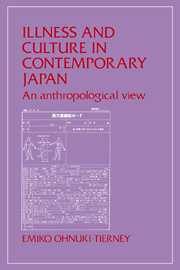Book contents
- Frontmatter
- Contents
- List of illustrations
- Acknowledgments
- 1 Introduction
- Part I Basic concepts and attitudes toward health and illness
- Part II Medical pluralism
- 5 Kanpō: Traditional Japanese medicine of Chinese origin
- 6 Medical roles of Japanese religions: A descriptive overview
- 7 Medical roles of Japanese religions: A historical-symbolic interpretation
- 8 Doctors and outpatients: Biomedicine (I)
- 9 Hospitalization: Biomedicine (II)
- 10 Medical pluralism
- Summary
- References
- Index
6 - Medical roles of Japanese religions: A descriptive overview
Published online by Cambridge University Press: 12 January 2010
- Frontmatter
- Contents
- List of illustrations
- Acknowledgments
- 1 Introduction
- Part I Basic concepts and attitudes toward health and illness
- Part II Medical pluralism
- 5 Kanpō: Traditional Japanese medicine of Chinese origin
- 6 Medical roles of Japanese religions: A descriptive overview
- 7 Medical roles of Japanese religions: A historical-symbolic interpretation
- 8 Doctors and outpatients: Biomedicine (I)
- 9 Hospitalization: Biomedicine (II)
- 10 Medical pluralism
- Summary
- References
- Index
Summary
Anthropologists are now increasingly interested in the pluralistic systems of medicine that characterize many complex societies of the Third World. In studies of medical pluralism, however, primary attention is usually given to narrowly defined “medical” systems, such as Japanese kanpō or traditional Chinese medicine in the People's Republic of China. Healing at religious institutions is accorded a separate category, sometimes with the implication that it is a second-class practice whose medical efficacy must be proved before it can be admitted into the ranks of legitimate medical systems. At the other extreme, romanticism on the part of anthropologists has made religious healing the most powerful healing method. In either case, this separate treatment is unfortunate, because people use these various systems of medicine simultaneously.
A tacit assumption behind the neglect of the medical role of religious institutions is that although religion once played a major role in health care, as in medieval Europe, the modernization process, especially scientific development, has separated medicine from magic and religion. In some cases this generalization may be applicable (see Thomas 1971), but the assumption ignores many instances of religion-based medical care in contemporary societies. Catholic priests in the United States, for example, still perform a vital role in health care: They perform special services for the sick and engage in psychological counseling of parishioners. The difference between the situation in medieval Europe and contemporary United States may lie in the fact that in the latter religion has become a nonformalized medical system, to which people no longer consciously assign a medical role, but which nonetheless delivers health care.
- Type
- Chapter
- Information
- Illness and Culture in Contemporary JapanAn Anthropological View, pp. 123 - 144Publisher: Cambridge University PressPrint publication year: 1984

